Apple MacBook Pro 13: Can a Mac Be a Decent Windows Laptop?
by Vivek Gowri on October 14, 2010 9:00 PM ESTApple MacBook Pro 13—Core 2 Duo Performance
It’s kind of embarrassing to be reviewing a $1200 computer with a two year old processor and application performance to match. It’s not that evident in day to day use, and in most games performance is more dependant on the graphics card, but application performance benchmarks are where the Core 2 Duo really makes itself felt (and not in a good way).
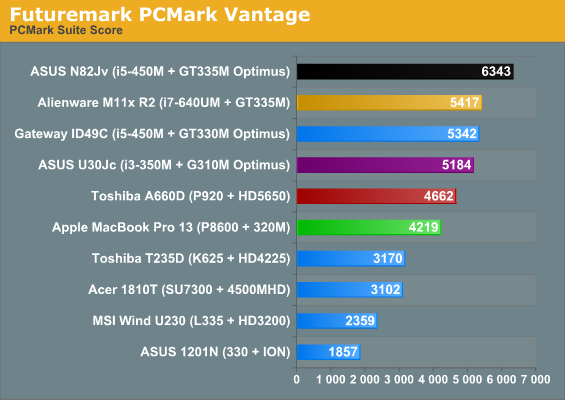
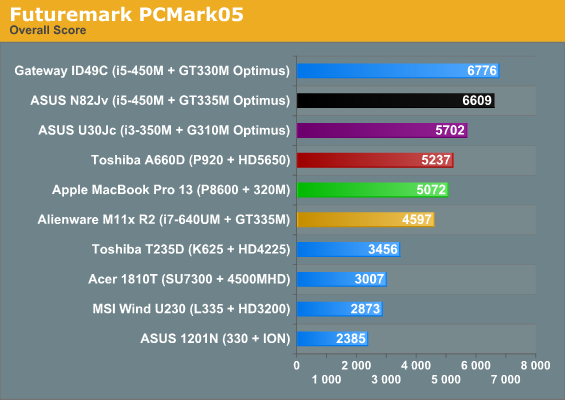
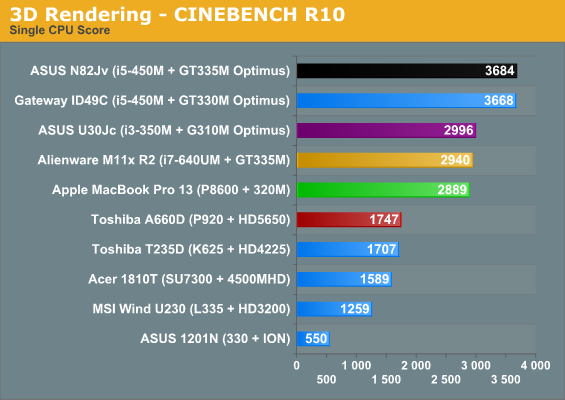
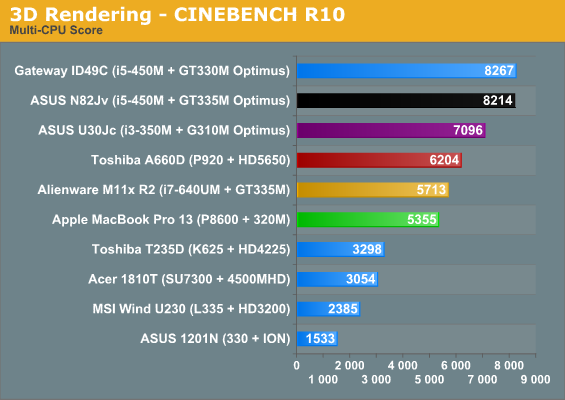
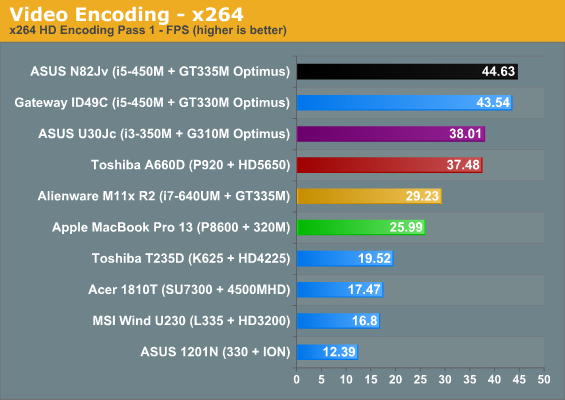
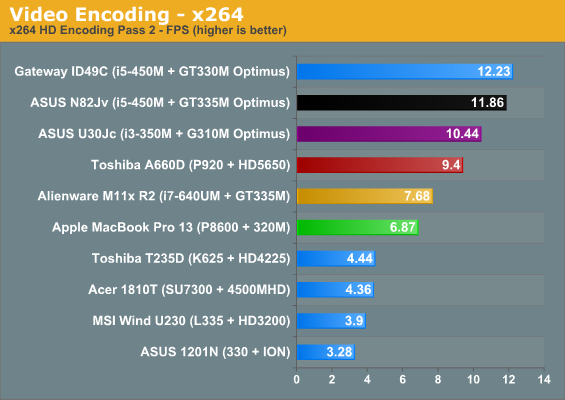
Here’s why it’s really sad: the MBP13 results would fit pretty well in our old Core 2 Duo notebook roundups, like this one from two years ago. The G50V and dv5t were $1200 notebooks back then, and they’re basically on par with the current MBP13. Quite frankly, it’s almost pathetic that Apple decided they could get away with a Core 2-based processor for another year at a price point that can get you a 14” aluminum unibody notebook with a quad core i7-720QM (HP, we’d still like to test an Envy 14, thanks). People expect Macs to cost more almost by default, but after a couple of years of the MBP13 being a decent value for a premium quality notebook (look at the old Envy 13 for comparison), it’s particularly jarring now to see it be so far behind the competition. I have none of these complaints for the Core i5/i7 sporting 15” and 17” models, however.
At this juncture, any notebook with a Core i3 can outrun the MBP. Same goes for the Core i7 ULV chip. We’ve never tested a Core i5 ULV, but we'll see the Core i3 ULV in a review shortly and it's in the same ballpark as Core 2—and the overclocked Core i3-330UM in the ASUS UL80Jt is basically on par with the MBP.
There are two ways you can look at this; you can say that at this point, anything with a Core 2 (even an old Merom) is more than powerful enough to run Windows and handle any reasonable task a thin and light notebook might be asked to. A lot of Apple fans say that. There’s another camp that says it’s completely unreasonable for Apple to sell a notebook with a Core 2 Duo processor at $1200, regardless of what it might be asked to do—there are smaller, thinner, lighter systems that perform better in basically every way. A lot of anti-Apple fans say that. They’re both right.
The Core 2 Duo is most certainly adequate to handle the normal, every day rigors of a portable notebook, but that’s not a reasonable justification for Apple selling a notebook that is more expensive than more powerful competitors. Apple is getting a bargain price on P8600 CPUs and the 320M chipset, which means the Core 2 + 320M is more about increasing profit margins than anything else. (And for those people who still cling to the theory that Apple couldn’t fit a third chip onto the board without reducing the battery size or making the notebook larger, that’s nonsense. If ASUS can manage to fit a Core 2010 processor, the chipset, and a dedicated graphics card into a system with similar dimensions to the MBP13 and a 33% larger battery, then Apple could have too. Simple as that.)
While we're here, we also ran all the 3DMark suites. This hints at the Core 2 + 320M combination being a lot more impressive than the above results, but then why couldn't Apple get GT 320M or faster with switching graphics into the system instead? Oh, right: that's only for 15" and 17" MBP. More on this when you hit the next page.
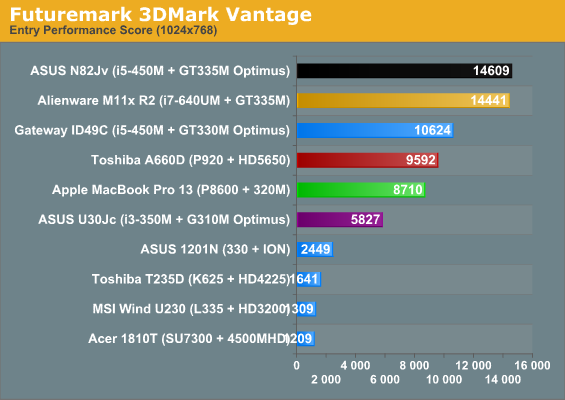
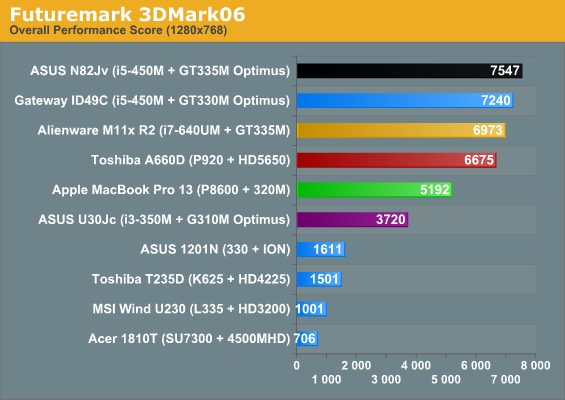
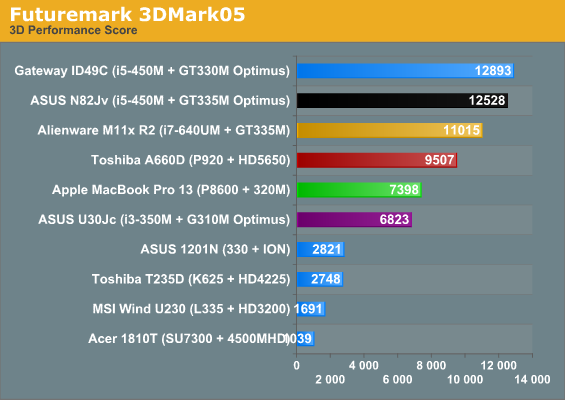
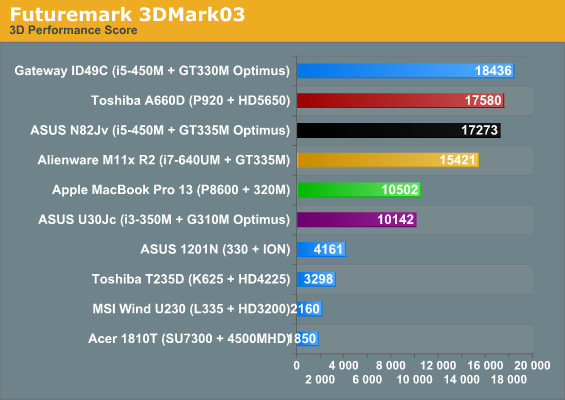
Okay, 320M looks decent, but the CPU is still old. We'll get into the graphics stuff on the next page, but while we're here looking at 3DMarks, we do have a quick question: how many of you want us to continue posting 3DMark results with our laptop reviews? We know they're a consistent point of reference for the long-term, but 03 and 05 in particular are getting very long in the tooth. So, if you want to sound off in the comments, would you like us to ditch 3DMark entirely, keep 06 and Vantage, keep all four like we've got above, or only skip 03/05?










117 Comments
View All Comments
JarredWalton - Monday, October 18, 2010 - link
We use the same settings on all of the laptops we test under Windows. Specifically, we start with the Power Saver plan (or if there is a manufacturer provided plan that's "better" we'll use that -- i.e. ASUS has Power4Gear Maximum Battery, Lenovo and Dell often have something similar). We also calibrate the laptops to run the LCD at around 100nits (95-105 nits depending on the laptop and how granular the brightness adjustment is). Then we set all of the other items to the same values: never power off the LCD, don't go to sleep, don't dim the LCD, minimum CPU 0%, maximum CPU 50% (this actually improves battery life, even though the "hurry up and go to sleep" concept suggests otherwise), HDD power down after 1 minute, WiFi at maximum power saving, etc.For idle battery life, we mute the speakers and disable WiFi -- a truly best-case scenario in every sense of the term. Internet we run muted but with WiFi on, and x264 we run with audio on (using headphones) and WiFi off. I did an article looking at battery life on a couple of laptops under Windows XP/Vista/7 and even Ubuntu a while back, and found that in most instances the Power Saver plan beat out the Balanced plan by over 5%, so for the last year that's what we've used.
I don't necessarily think all of our settings are "best" for actual use (i.e. you might prefer a bit more performance and a bit less battery life that the Balanced plan provides), but the tests are as equal as we can make them on each laptop. Note that we also uninstall and/or disable all of the extra utilities, firewall, anti-virus stuff, etc. on the laptops. Some Internet Security suites can absolutely kill battery life (McAfee and Norton in particular), so we run clean. If you buy a laptop we review, take it home, boot it up, and run a battery life test, you'd almost certainly get less than our idealized setups.
Hope that answers your questions.
Setsunayaki - Sunday, October 17, 2010 - link
Ever since the Software Development Suit for Multimedia creation and Animation was released on Linux and programmed by Development Fanatics in those areas who turned computer programs....The apple equivalents have fallen shorter and shorter with each generation.I remember how I felt when I moved from a MAC development platform to a Windows Development Platform and found myself wondering why out of many programs out there, each was incomplete in one way that forced me to run 2 - 5 programs for each thing...
When the Linux Development Suite was released, for the first time I got a software suite installed which not only was actually free, but for the first time performed better than both Windows and MAC in what I was doing. What was great about it all was that I didn't need a Quad Core for using 2 - 4 programs and processor scheduling really helped in those programs...
Linux has always been a development platform and server platform and for a while was really dominated by Windows and Apple when dealing with Graphic Design, but the latest programs out there are organized into a large suite of programs for the designer that while it requires more hardware to use...The software is actually complete in the sense I was able to develop with it without having to get 2 - 5 different programs for each task...
So what I really have to say to any MAC laptop for development is
"Those days are long since past...the expense of those programs and the lack of optimization destroys the purpose of owning a mac. Most Macs today don't even have those basic packages installed and high end programs, they are on the side people have to shell out tons for....so you do get a pretty basic computer on a MAC these days.....so basic that comparing it to any Linux build out there...you will get more on Linux."
No amount of money is worth it for the hardware found in this laptop....first thing I do on many laptops is change the OS to Linux and put in a good minimalist DE and the binaries for the others...and start downloading what I need from repositories and It gives me peace of mind.
Sure I have to spend 4 - 10 hours configuring things and adding scripts, but when I am done...it just blows away mac and windows performance.
Henk Poley - Tuesday, October 26, 2010 - link
* "Software Development Suit for Multimedia creation and Animation"* "Linux Development Suite"
What are you talking about? Do you mean TimeStorm: http://www.timesys.com/embedded-linux/tools ? Or the Ark Linux Development Suite from 2005?
I suspect what you mean to say is that there are distros now for multimedia creation, using applications with sound and image manipulation plugins. But why talk about it in such vague terms? Is steganography in there or something?
Theguynextdoor - Sunday, October 17, 2010 - link
So I can't believe nobody will send you an Envy. So I will volunteer mine, if you're intrested just take care of the shipping and I will ship you my Envy 14 for review. It's about 3 months old. I have the i5 - 450 (sorry I was looking for battery life so no i7).I have the 4GB (single stick) and the optional slice, there's already significant wear on the battery (8%) (with the slice it lasts the entire school day for me (approx 6-8 hours) with max brightness on balanced with the intel GPU.
If you have questions or intrested just drop feel free to ask.
VivekGowri - Thursday, October 21, 2010 - link
Can you email me at vivek@anandtech.com please?mutatio - Monday, October 18, 2010 - link
The issue Apple faced was whether to use an effective and successful chipset and integrated GPU (nVidia) over the intel HD offerings. As you see in the GPU analysis intel's offerings offer doodoo in the GPU arena. I think Jobs was even overt about it basically saying they didn't want to see the system take a hit by going with a straight intel solution where CPU performance would be marginally better than the C2D while the graphics and usability take a significant hit due to a sluggish integrated intel solution. Your comparison of the benchmarks for CPU and GPU illustrate that very point. In overall usability I really don't care if my laptop CPU can do 15fps better rendering in Divx conversion. I do, however, care if I can watch 720p or 1080p movies or TV shows while doing other run of the mill office work. Yes, you can argue about the use of older hardware, but it seems your review also missed another aspect of Apple's decision to go this route, which was intel's unwillingness to license the Core i3/5/7 chipset tech to nVidia. Has intel still not learned about being non-competitive in its practices?At this point, yes, the 13" model is getting long in the tooth from a hardware standpoint. On my end, being a Windows and Mac user with my home built tower for Windows 7 and my 13" 9400M C2D MacBook Pro, I do most of my computing on the latter with it plugged in via my KVM switch and used in a largely desktop mode driving a 1920x1200 26" monitor. Should Apple find a more current solution for it's entry level MBP? Yes. But your article (and yes I know this is cliche territory) didn't really get into market differences between Macs and PCs. While you can argue that Apple, in charging a premium for their systems, should by default have the most bleeding edge tech in their computers, you seem to be forgetting Apple's seemingly perpetual focus on usability as a huge focus in their development of systems. On the other side of the coin, you have, well, everyone else, who plays in the razor-thin-profit-margin-land whose slim pickings require the unending tech spec rat race in order to try and keep the slim sales margins coming in. Apple had the luxury of being able to make a decision, as your benchmarks indicate, of using an older CPU with newer GPU tech to balance out the equation of how usable/functional the system is for consumers (and again, this was in light of intel cutting competition off from nvidia for the Core i chips). Some may not like the decision Apple, made, and certainly the profits are in the picture, but them's my 2 cents. ;-)
atscntsc - Wednesday, October 20, 2010 - link
From laptopmac.com"Unfortunately, the N82JQ-A1 is short on gas and stalls on the road with very poor battery life (2 hours and 2 minutes), unacceptable for a 14-inch notebook. We also recommend gaming with this solely on a desk at all times, as our system spiked to a scorching 130 degrees 20 minutes into a gaming session.
In the end, the $1200 N82JQ-A1 is hard to recommend when it comes to overall value, and the battery life is a total bummer. Read the full review here"
Read more: http://blog.laptopmag.com/asus-n82jq-a1-reviewed-a...
mojtabaalemi - Thursday, October 21, 2010 - link
the reduction of battery life in windows is probabely because of geforce card that is always on!is there any way to use optimus drivers in mac books ??
davidcmc - Friday, October 22, 2010 - link
What NVIDIA graphics driver did you use for the GeForce 320M?The one that comes with Mac OS X Install Disc is just too old (19x.xx, I think). Also, I've noticed that there's no driver for 320M listed in NVIDIA site.
SaberOne - Friday, October 22, 2010 - link
I'm using my decade old 22-inch Apple Cinema Display as I type. It’s Apple’s very first flat panel LCD and it still easier to view better than my son’s MB. I absolutely hate the glossy panels that are more suited for applying make-up or popping zits!